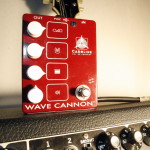 In this installment of our FAQ, I tackle our company name, controls, icons, LED color choice, integrated circuit chip, asymmetric clipping, and a host of other stuff that may get dorky. Oh who am I kidding? It’s all dorky.
In this installment of our FAQ, I tackle our company name, controls, icons, LED color choice, integrated circuit chip, asymmetric clipping, and a host of other stuff that may get dorky. Oh who am I kidding? It’s all dorky.
Why are you Caroline GUITAR Company when you have no guitars?
Great question. I registered that name when I was investigating a possible guitar design and patent that I wanted to develop. In the meantime, the distortion pedals idea came together a lot quicker. We gave serious thought to changing to “Caroline Electric Company”, but considering how often the rainstorms knock the power out around here, do I really need a bunch of angry people calling us every couple weeks asking when their power will be turned back on?
What do your controls mean? I love how this sounds, but can’t make heads or tails of this thing.
Our manual is available for you to download for free, but here’s my fast explanation. Shapes = GRIT, Ronnie James Dio hand = GAIN, Stacks = HIGHS, Speaker = VOLUME.
We recommend starting with the Speaker at 12:00, the Stacks around 2:00, the Hand low at 9:00. Turn the Shape to find whatever seems to clicks best between the guitar and amp, then add gain and decrease treble to however rocking you are feeling that moment. After that, adjust the volume to give a slight volume boost when the effect is turned on versus bypass. Flavor to taste.
Who came up with your icons? Are they inspired by Orange® amplifiers?
I came up with our icons as poorly drawn sharpie markings on a prototype, then they were cleaned up and redone by my friend Brenton Sadreameli (of Mr. B’s Bottleneck Slides), and my friend Dru Cameron. We stuck with them because we observed guitar players who used our prototype with typical distortion pedal verbiage (gain, tone, volume) stayed between 11:00-1:00 on the settings, but the players who used the ones with icons turned knobs to wherever they thought the pedal sounded best.
Yes, we know they can make you uncomfortable. But rock and roll isn’t comfort! Last time I checked, no great rock and roll performances have been performed while wearing relaxed fit khakis in an air conditioned cubicle sitting in your ergonomic Herman Miller aeron chair.
Why are you using a blue LED on the Cannon?
I like the blue LED on our Wave Cannon because red, white, and blue is the most successful color scheme in Western civilization. True story.
Does the Wave Cannon use the [4558 chip/asymmetrical clipping/germanium transistors/carbon comp resistors]? I’ve heard that the pedals that use the [4558 chip/asymmetrical clipping/germanium transistors/carbon comp resistors] sound the best, and most tube-amp like.
This is just a sampling of the kinds of questions that reflect how muddied the water is by technical information masquerading as marketing language, and vice versa.
If all it took was using any or all of the above inexpensive parts to make the pedals the best, and most “tube-amp like” (whatever that means), then that is all anyone would have ever used.
We encourage you to judge with your ears, not the spec sheet. I’ve stopped talking about this stuff with people because I’ve seen people change their minds about the product based on something I’ve said. They’ll be loving the Wave Cannon, ask me about what inspired or goes into it, and if I say the wrong thing, they’ll change their minds! “Oh, I don’t think I can buy it now, because I never liked [any number of things that I could mention].”
We want you to get over any gear-identity politics in your guitar playing. You’re not a “germanium boost”, an “alnico magnet pickup”, or a “new old stock tubes” user. You are a human being and a musician, and your only obligation is to use what inspires you to play and create. If you like what we do, our commitment is to build the best stuff that can give you a lifetime of enjoyment.
Thanks! – Philippe
